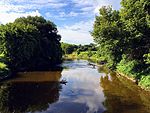Tittabawassee River

The Tittabawassee River ( TIH-tə-bə-WAH-see) flows in a generally southeasterly direction through the Lower Peninsula of the U.S. state of Michigan. The river begins at Secord Lake in Clement Township, at the confluence of the East Branch and the Middle Branch. From there it flows through Gladwin, Midland and Saginaw counties where, as a major tributary of the Saginaw River, it flows into it at Saginaw. Its tributaries include the Chippewa, Pine, Molasses, Sugar, and Tobacco rivers. Significant communities on or near the Tittabawassee River include Saginaw, Midland, and Sanford. At Edenville, the river was impounded by the hydroelectric Edenville Dam to create Wixom Lake. It was also impounded by a hydroelectric dam in Sanford to create Sanford Lake prior to the dam failures and resulting flooding on May 19, 2020. In Saginaw County, the river flows through Tittabawassee Township, which is named for the river and contains the unincorporated community of Freeland. The main river is 72.4 miles (116.5 km) long and drains an area of 2,471 square miles (6,400 km2).
Excerpt from the Wikipedia article Tittabawassee River (License: CC BY-SA 3.0, Authors, Images).Tittabawassee River
Wickes Park Drive, Saginaw
Geographical coordinates (GPS) Address Nearby Places Show on map
Geographical coordinates (GPS)
| Latitude | Longitude |
|---|---|
| N 43.38669 ° | E -83.96608 ° |
Address
Wickes Park Drive
48602 Saginaw
Michigan, United States
Open on Google Maps









